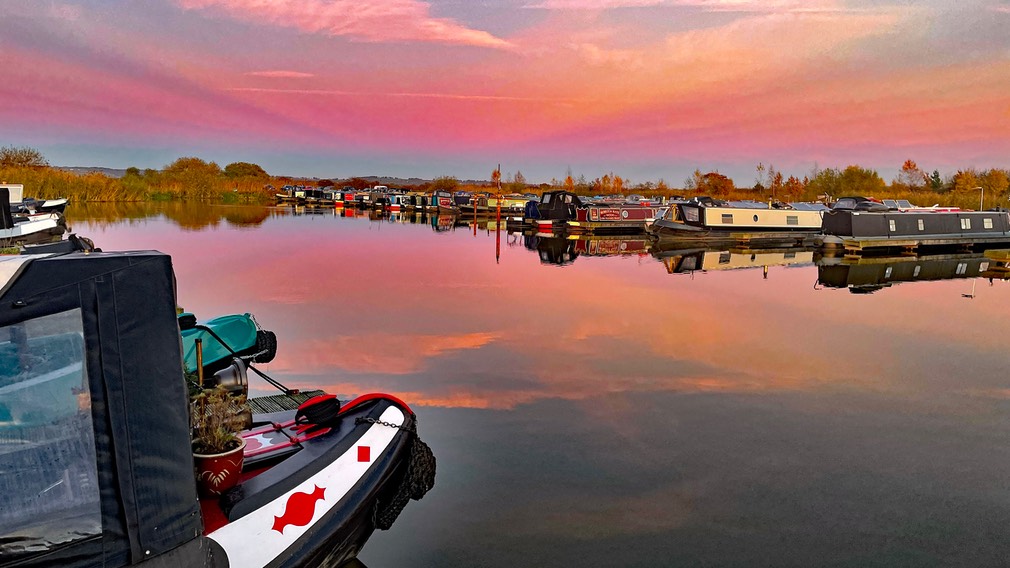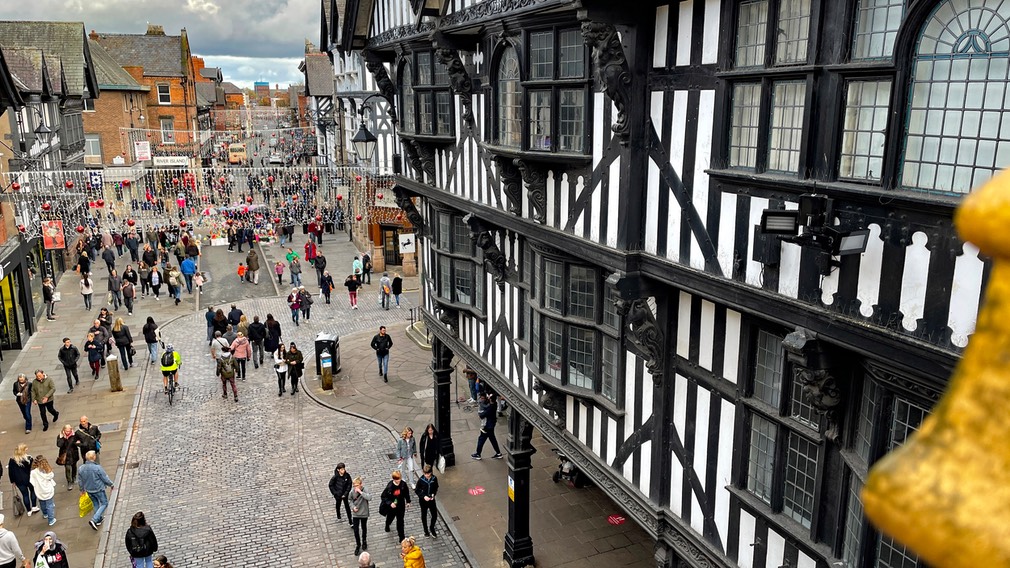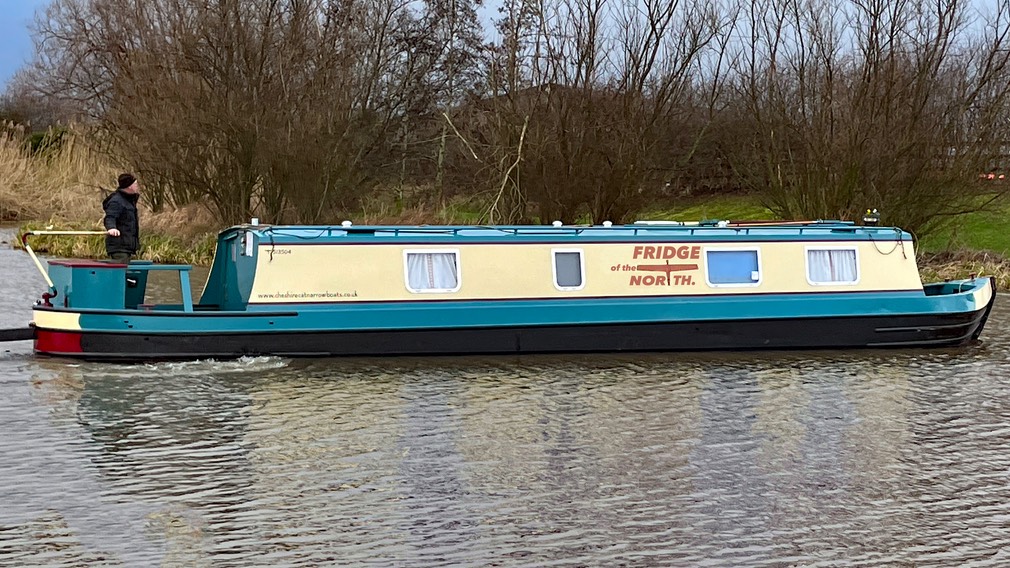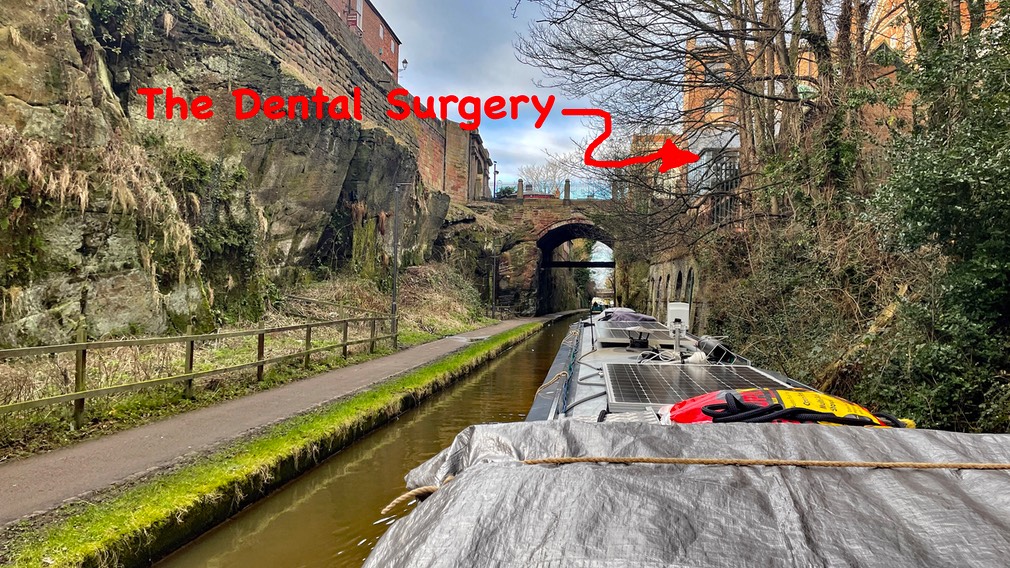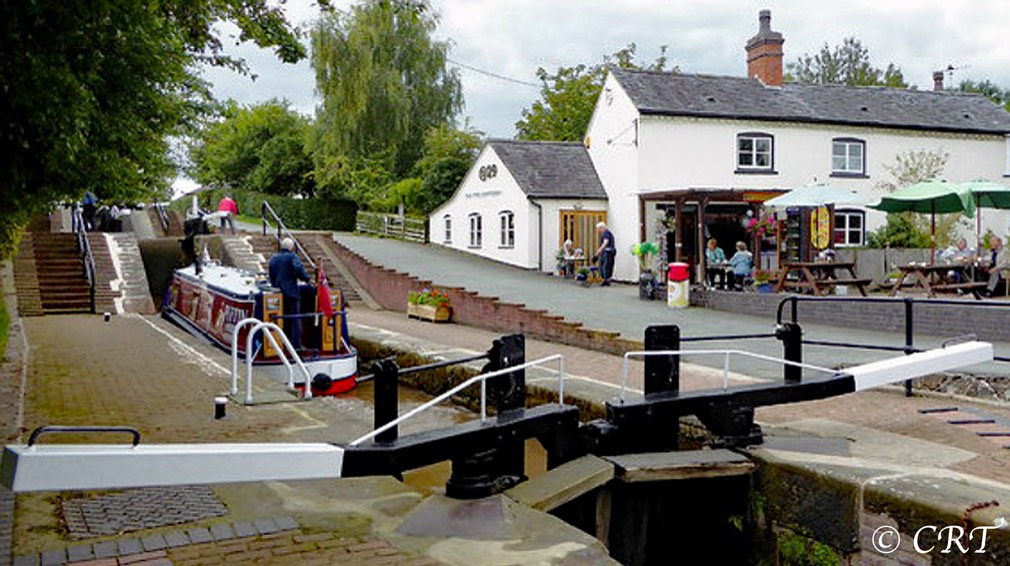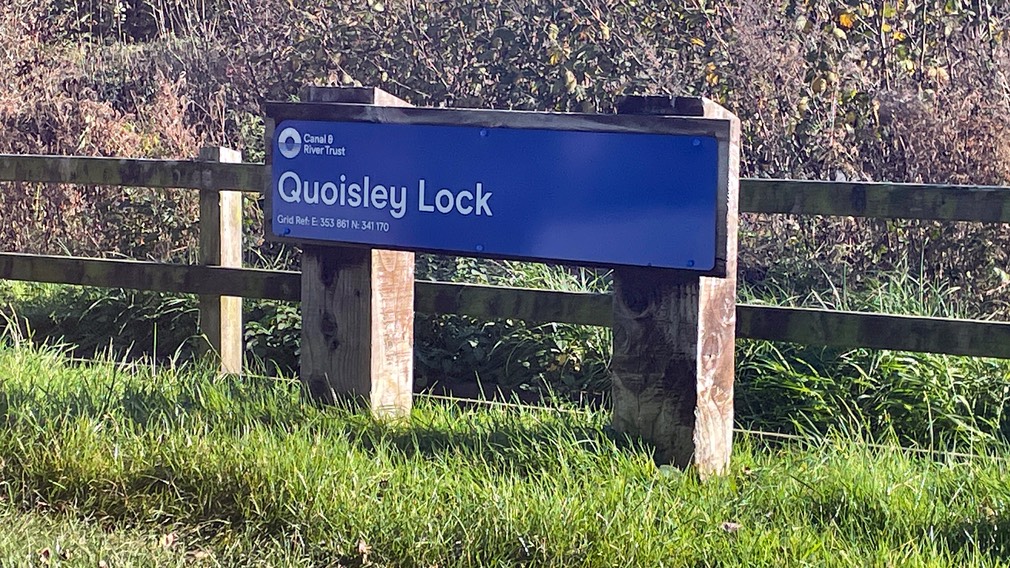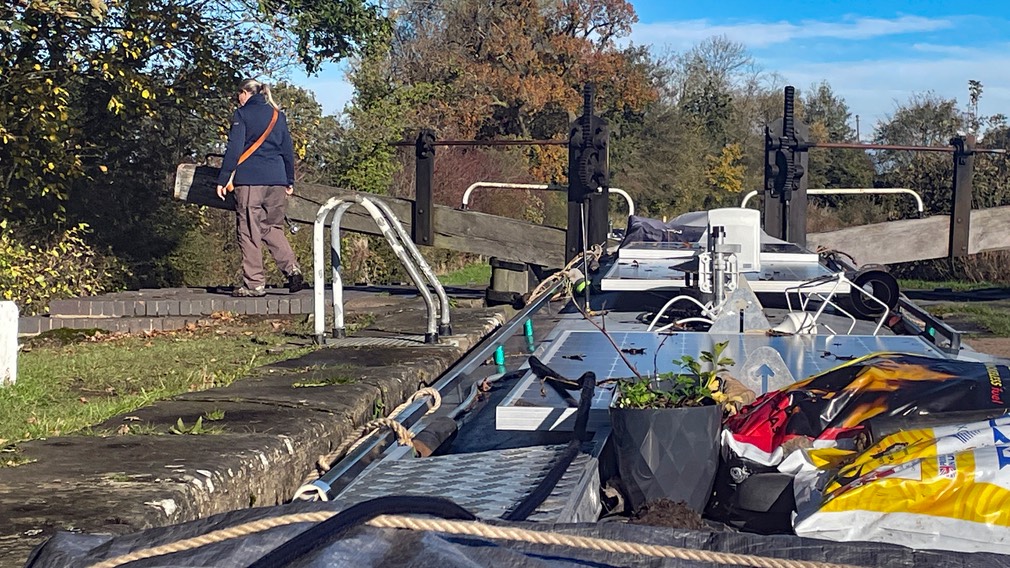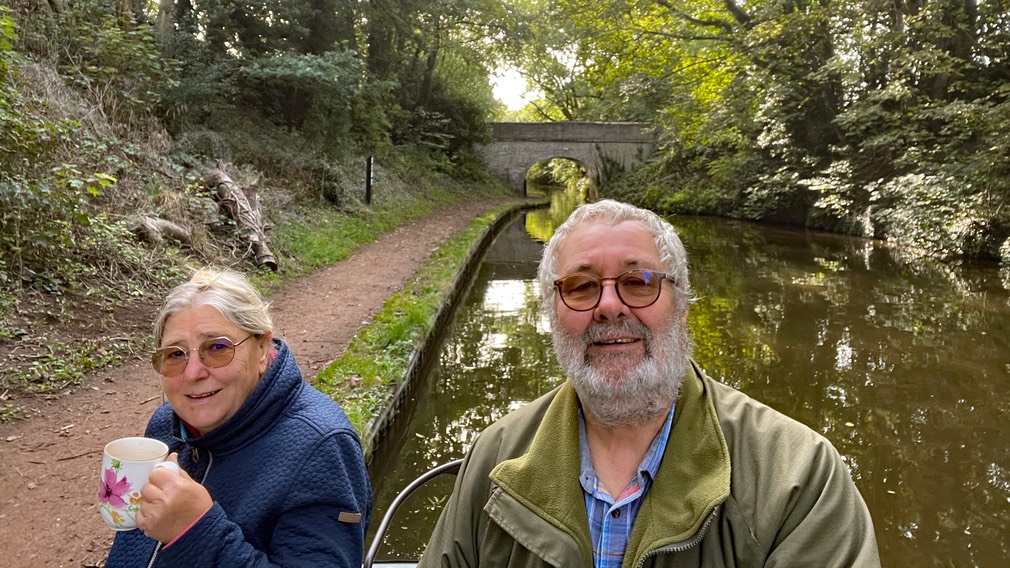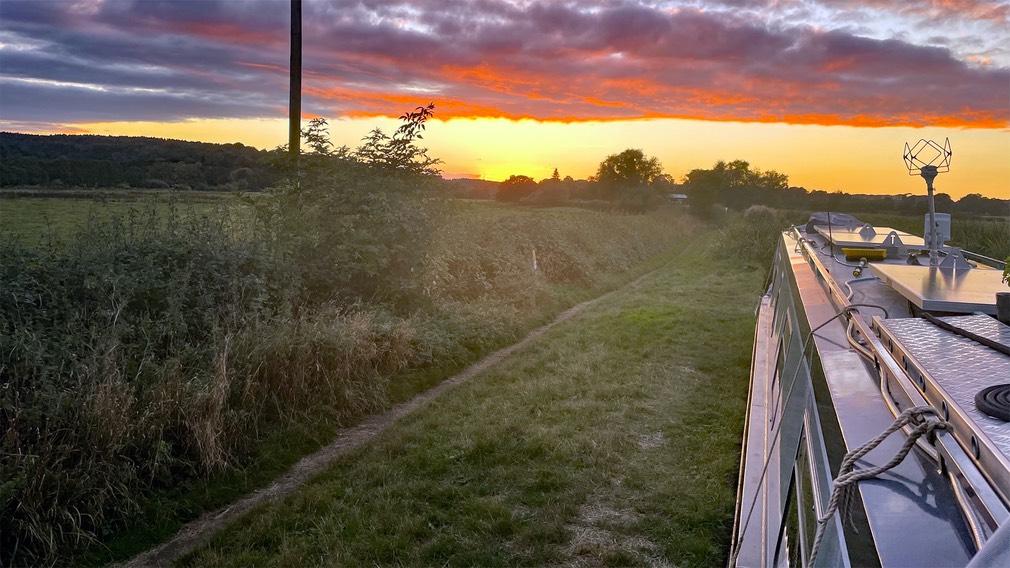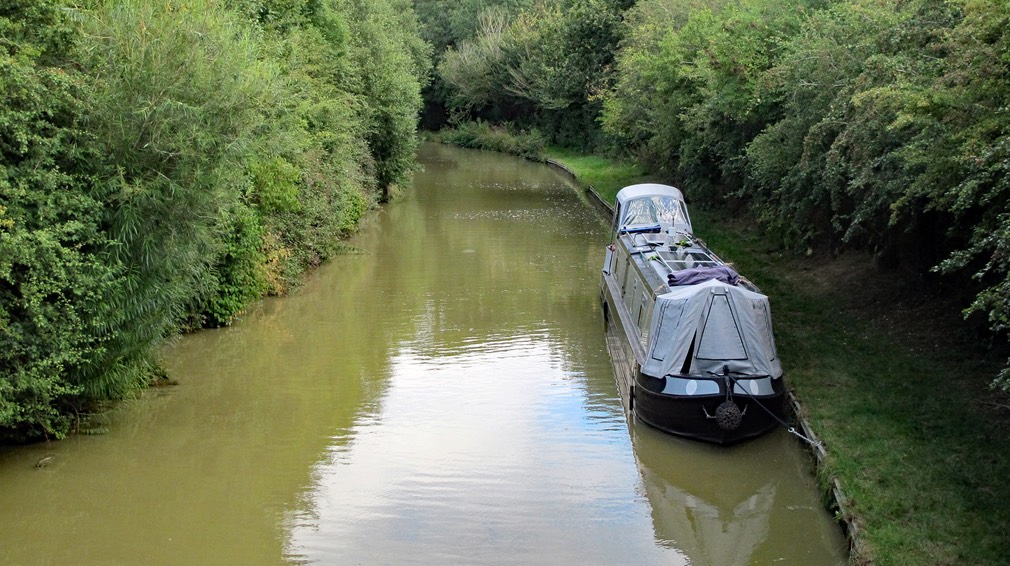Marina Living. To Christmas and beyond.
Only the second week in the marina and we are bored to tears and questioning if we have made the right choice.
Spending almost the entire first year of owning RoJo in Calcutt Marina was quite different as then we had a long list of jobs needing to be jobbed and a car to make fetching materials and day to day shopping easy.
Here we are much closer (around 12 minutes on our e-bikes) to a well-stocked, if expensive, convenience store, a pharmacist, where we got our first-ever flu jabs, a couple of pubs (one of which hosts a Chinese restaurant/takeaway) and an Indian restaurant. There is however a BUT and it’s a big BUT. There is nowhere locally to buy DIY materials, there is a builders merchant less than a ten-minute e-bike ride away but they sell only in builders quantities, smallest length of timber 5m, etc., etc. We did however book the boat in for blacking. It had been done just eighteen months ago and requires doing every three years but the condition of the current blacking was poor so while we had the time . . .
The earliest it could come out is 7th February and when the actual work could be carried out was anyone's guess as it is very weather dependant.
The boredom was relieved when pal Mark came to visit. A boat cruise to Chester city centre and the National Boat Museum at Ellesmere Port was planned but just before we left kindly locals reminded us that winter stoppages had closed Grenfield Lock No 8 cutting off both our planned destinations. We went anyway for a one day cruise but were able only to travel to Quarry Bridge Winding Hole around 0.75 miles from the offending lock. Wandering up to the lock we “gongoozled” the work team cleaning the lock and making it ready to repoint the leaky brickwork and install a new lock ladder.
As cruising was out Mark kindly offered to act as chauffeur and for the duration of his stay took us to many of the local hotspots. A day was spent walking the ancient Chester city walls, another at the Anderton Boat Lift, aka the cathedral of the canals. It was a busy week as we also packed in visits to The National Boat Museum, Beeston Castle and Flint Castle.
There were many very interesting aspects of each of the trips but if forced to pick a favourite it would probably be Beeston Castle as within the walls a group of volunteers have recreated a roundhouse, the post holes of a similar dwelling having been found nearby. The roundhouse was constructed using the tools, technologies and methods exactly as used for building the original and except a second door (it is used by all ages of school children for education purposes so a fire escape is essential) and one or two other tweaks to allow it to be used by these children it is exactly like the original. Just as exciting was the knowledge base of the two volunteers (one of whom was on the build team) who were able to answer any questions we put to them.
Mark eventually went home and it was back to the boredom!!
I should say that the other liveaboards are pleasant and the Boathouse a warm and welcoming environment, indeed before Mark went home we had another meal there where Mark and I settled on the fish pie while Sue chose Moroccan Lamb. The fish pie was (almost) as good as the fish pie Sue makes, lots of fish, at least three different types, one smoked, a creamy sauce and quartered hard-boiled eggs mixed with the fish and sauce - divine. Sue also reported her meal as excellent.
Christmas was very quiet as our Christmases have been for some years but unlike last year we did manage to get a decent-sized turkey leg from a local farm shop. After Christmas we managed to get a two bone french trimmed rib of beef from another local deli and butchery shop, sadly this shop, located in a pub car park does not have a website only a Facebook page. The quality of their meat is superb.
Mark came for another visit on New Years eve (to share the fabulous roast rib of beef - THANKS Sue) but sadly the weather was not good enough to do any sightseeing so we researched a part re-fit of the galley (kitchen). We, by that I mean Sue, wants to replace the sink with a round one, replace the oven and grill with either a freestanding cooker or another oven and grill and replace the worktop.
We spent hours on t’interweb but were unable to find a freestanding cooker that we could fit in the available space, neither could we find an oven/grill combo that would fit in the existing aperture. Well, it could be altered so we decided to go to Currys and have a look-see and chat with someone in their cooker department. Well, what a waste of time!
There was nothing that was even remotely near to fitting and the staff had no knowledge, just a tablet with which they accessed the Currys website so it was on to plan B, we would replace the current one with another the same.
The sink was not a great problem although when you looked at each one there were a series of problems that eventually reduced the choice to a Hobson's choice of one. Still, Sue was happy with that so it was on to the worktop, which we thought would be easy. In a pig's ear!!!
Many of the worktops Sue liked were a standard 2m long, we needed 2.5m. Of the standard 3m tops on sale, we wanted a thin non-chipboard type. All of these were on extended delivery so we were down to the bog-standard 38mm thick laminate worktop. Sue picked out one that she could happily live with that particularly as the price ticked indicated it was a stock item. We would have to hire a van to get it back but never mind the top was much cheaper than we anticipated. We went to the counter to place an order for the sink and worktop, the sink was a stock item but the worktop was on (at least) a month's delivery with no firm date available.
After mulling over what we had learned we decided, at this stage, to replace the oven with a like for like. The marina said that they could order one for us from Midland Chandlers, we would pay the web price they would get a resellers discount and we would not pay postage charges, a win-win all around.
The grill/oven unit arrived as promised and we set about swapping it with the original.
What a job that was. In the original build, the units had been partly built, then the grill/oven installed and the remainder of the galley built around it with the last item being the fitting of the worktop. We had to slowly and carefully cut away pieces of timber until we could eventually remove the old cooker. It was then we discovered that the gas connection to the new was different from the old, we needed some other bits to make the connection which we could get from Midland Chandlers the next day, unfortunately, Mark needed to go home the day after and as he was the guy qualified to carry out the work we could not afford more problems. Happily, when we arrived at Midland Chandlers the next morning they had everything we needed and by the evening we could have toast for the first time since we bought the boat.
While we were researching the kitchen we had a visit from another pal, Paul, a man of great knowledge and narrowboat handling skill, it was he with whom we booked an “Experience Day” back in 2019 when we first started researching narrowboat living and it was on this day we learned that RoJo was for sale. Paul had just retired but because of water draught constraints with his own boat NB Orient, he had chartered a boat for six weeks to explore the upper Trent and Mersey Canal and the Chester section of the Shropshire Union Canal. Paul's original plan was to first explore the Chester Canal and visit the National Boat Museum which would mean passing Tattenhall Marina so he arranged to visit us for a few days. Sadly the Boat Museum was closed for a couple of weeks so Paul decided to reverse his route and visit The Anderton Boat lift and River Weaver first and then return to the Chester Canal, when he did we would cruise in company with him to Ellesmere Port and back. As stated Paul is a very experienced and skilled narrowboater, but skill means little when you find you have chartered a boat with no coal stove and a totally inadequate central heating system. During his six weeks hire the highest temperature he managed to achieve in the cabin was 5˚C, the boat was soon nicknamed Fridge of the North (real name Angel of the North)
After one missed and two dentist cancelled appointments we finally got to see a dentist. It was suggested that as my appointment was 12 till 12.30 and Sue's appointment was 12.30 to 13.00 we went in together. The dentist was very interested in narrowboats and asked lots of questions before I got in the chair and was asked the first question any dentist asks as an appointment opener “any problems?” I explained I had one very wobbly tooth and one broken tooth, he turned to Sue and asked the same question, she answered that she had a broken tooth.
The upshot was he took X-rays of both my troublesome teeth and said neither was saveable and both would have to come out. He examined Sue’s broken tooth and declared he could fix it. I went back in the chair and he pumped lots (or so it seemed) of local anaesthetic and I retired from the big chair while my mouth went numb, during which time he repaired Sue’s tooth before extracting my two problems. What a star, he could have gone through the usual checking and recording all our teeth and made another appointment, at least a month away, but sorted us so that we can get away as soon as the weather improves.
Paul returned the day after our dental work, we were hoping to set off early but Mark was going to join us and could not get here until lunchtime.
We set off around 13.00 left the marina and turned left to go north to Chester and beyond. The trip there and back is a total of 32 miles and 16 locks, with such experienced fellow travellers as Paul and Mark the trip was very pleasant, it took four days. On the last of those four days, the wind was blowing fit to burst but we needed to get back because the next day Sunday RoJo is being pulled out of the water to have her bottom blacked so we must go into the marina. As we got into the marina and felt the strength of the wind I handed the helm to Mark with a cry of “ . . . you are a better helmsman than me you can take her in . . . “. It turned out to be an inspired decision as, although he missed on the first attempt and had to go around and try again, successfully, at no time did Mark lose control or hit any other boat or marina structure. The next day I was approached by the marina managers who congratulated me on my entry, I was tempted to accept the credit but did the right thing and explained I was not on the helm. I also rang Mark and informed him of the conversation.
Continuous Cruising Week 18,1st - 7th November.
We didn’t move on Monday as yesterday's storm still hadn’t blown itself out so we did little jobs but mainly we relaxed.
Provided there are no more unscheduled stoppages, we now have plenty of time to get from this mornings (Tuesday) mooring to the other side of the first winter stoppage at Baddiley Lock No 1. We should pass through it early this afternoon.
It’s great when a plan comes together and, as hoped, by the time we moored we had passed through the remainder of the locks on the Llangollen Canal turned left at Hurleston Junction back onto the Shropshire Union Canal towards Chester passing Barbridge Junction before mooring at the Barbridge public moorings.
Opposite the moorings was The Olde Burbridge Inn and we decided to wander over for dinner that evening but sadly when 7.00 pm arrived neither of us could be bothered to walk the 100 yards to the pub so we ate in the boat.
Today (Wednesday) was one of our (hopefully not the) last days out on the cut this winter. Today was a pleasant cruise of eight miles and six locks which included Beeston Iron Lock.
Constructed in 1828 Beeston Iron Lock was engineer Thomas Telford’s solution to the problem of “running sand”, the unstable substrate had rendered the previous stone lock unusable. Flanged cast iron plates were bolted together to form the sides and floor of the lock, a novel solution to a difficult problem. The lock, unique in England, is “grade II” listed and a scheduled ancient monument.
We reached Tattenhall Marina around mid-afternoon and were quickly booked in and allocated a berth. We had reservations about coming here as, although several people we spoke to had good things to say, one person complained that it was very run down and the pontoons were old and in very poor condition. We don’t know what the marina had done to upset this person but looking around what they said was incorrect, all the pontoons look new(ish) and in good repair. There is also a comfortable looking bar/restaurant called The Boathouse, which since the pandemic, is running on reduced hours but we are told serves very good food.
Friday night is fish and chip night in The Boathouse and because we did not fancy going out we asked if they did takeout. They did, so we ordered fish and chips for two at 7.00 pm. Arriving at the bar my shopping bag was taken from me and a few minutes later returned full of wonderful smelling food. Rushing back to the boat we found two large pieces of fish, two huge portions of chips a large container of mushy peas and a generous portion of tartar sauce. It was one of the best fish and chip suppers we have ever had and at just £10.00 each very good value.
So good was our fish and chips that when we learned that on Saturday there was a Tapas Night with live music we booked a table. We were not disappointed, the tapas were not just Spanish but included snacks from several European countries and included vegetarian and vegan options. All were delicious - at least all the ones we sampled.
Oh, and the music was great, loud enough to enjoy, quiet enough to carry on a conversation although to be fair there was little or no talking while the singer was performing.
Sadly I am writing this sometime after the event and neither of us can remember exactly what we ate, only that it was top-notch grub at reasonable prices. We will come again.
Continuous Cruising Week 17.25th - 31st October.
After having completed our plan to cross the Pontcysyllte Aqueduct we now had to get off the Llangollen Canal before the first winter stoppage on the 8th November 2021 when the Baddiley Lock No 1 closes for around a month, followed by a total of eight other closures which effectively cut access to the Llangollen Canal untill well into March 2022. But with 15 days till then we had plenty of time to complete the three day journey.
Monday started well, we got underway a little before 10.00am and six hours later we moored at 48 hour moorings just above the Grindley Brook Locks. The weather forecast had predicted very high winds for the next few days so we had words with the lock keeper about overstaying for a day or two till the weather moderated. To which he replied that he was happy for us to stay, and provided no local busybody complained there should be no problem.
It was a good place to stop as there was a water point, a rubbish disposal point, toilets and showers all provided by CRT (Canal and River Trust) and all accessed with our British Waterways key.
Tuesday morning we wandered down to the locks to watch them in action. The first three are a staircase lock flight with one of the only paid lock keepers on the canal system, although there are some on the Thames and other rivers. We were chatting to the lock keeper when a boat arrived to go down and the lock keeper stated that above the locks was the last possible winding hole and although he could not refuse passage he would advise against it. Advise against “passage through the locks why?” we asked. “because Quoisey Lock is closed from this morning until further notice with a gate problem” he replied.
Information came in dribs and drabs but it would appear that a “temporary” repair carried out on one of the Quoisey Lock gates 20 years, yes you read that right, 20 years ago had failed and although another temporary repair was planned if it was not successful the lock would be closed until March when a new gate would be available.
Wednesday and Thursday passed pleasantly enough with hot showers etc on tap and pleasant neighbours, Friday was make or break day, the repair would be carried out early morning then testing would take place. If successful the lock would open at 4.00pm if not - well!!
Fortunately all was well and well before 4.00pm a stream of boats was descending the Grindley Locks on their way off the Llangollen Canal.
We left on Saturday morning and after 10 locks and one lift bridge moored just before the Wrenbury Lift Bridge.
There were several reasons we moored here, but the most important was having been told by an Australian boater (adopt a Aussie accent when reading the next sentence) “ . . . it does the best bloody fish an’ chips in the UK . . . “
That evening we went to the fish and chip place he recommended and it was as good as he said. We did wonder when we got there as it turned out to be a temporary type building in a pub car park, but as stated above the food, fresh and cooked to order, was superb.
The weather forecast for Sunday with winds up to 72 mph, which is violent storm force 11 on the Beaufort Scale, so we stayed where we were. Others moved and possibly finished the day like the hire boat that tried to moor in the space in front of us. The wind was blowing off the towpath and the skipper had put one crew on the cratch (front) with the bow line and another in the cruiser stern with the stern line and tried to motor into the gap. Had the bow man been fast enough to jump off and secure the line the stern would not have blown across the canal, because as he tried to slow down the boat was simply being blown across the canal. After trying several times to get close enough to allow his bow man to jump off I went to try to help. I told the bow man to forget the bow line and throw me the centre line, which he did. I was able to get a couple of turns around a mooring ring and slowly - very slowly - swagged in the rope until the boat was alongside and the crew were able to assist in mooring securely for the night. By jabbers it was hard work! Why don’t (some) hire companies tell their customers about the merits and uses of centre lines?
We should perhaps at this point come clean. We have wimped out of travelling the canals over the winter and decided to go into a marina for a few months. The grass towpaths were already becoming a quagmire and jumping on and off the boat was threatening to become a slippery nightmare. We had it seemed left it rather late to start looking around and the first place I rang almost laughed at me when I asked, but was good enough to give me a list of those local marinas that may have space. I started ringing round and eventually found space at Tattenhall Marina, only two days travel from where we were currently moored
Continuous Cruising - Week 1618th - 24th October 2021
We had a phone call list night, pal Mark, asking if he could join us for our cruise on Llangollen Canal, “of course”, was our answer “but we are already on it”. After discussion it was agreed that we would meet him at Ellesmere which we thought we would reach by Wednesday and he agreed to meet us there, leave his car somewhere, and complete the rest of the journey with us to the Pontcysyllte Aqueduct turn at the winding hole after Trevor Basin and return with us to Ellesmere where he could retrieve his car and return home.
The journey to Ellesmere was quicker than we anticipated and by Tuesday evening we were moored just after the Ellesmere Tunnel around a mile from the town centre and 3/4 mile from a Tesco Superstore. The next morning we walked the towpath towards town and found a couple of moorings less than 400 yards (350m) from Tesco and swiftly moved the boat to one of them. Getting to Ellesmere a day early enabled us to stock up at Tesco and the independent stores in town and get the laundry up to date, as there was a laundrette within easy walking distance of the mooring and even found a place where we felt Mark could safely leave his car.
A couple of nights ago with the nights drawing in and getting cold we lit the stove. We had bought a number of “instant light heat logs” and used one to get it going. The boat filled with smoke and we coughed and spluttered while the smoke alarms went berserk. After some research we discovered (from social media so it may be true or may be complete Boll rubbish) that this could often be a problem on the first lighting of the season. We tried again and on second lighting all was well and we had a warm cosy evening. Last night we tried and tried but could not get a fire established. I stripped the stove and cleared the flue, which after just a couple of hours use since last brushing, was blocked solid. I looked at the stove scratching my head and thinking that something I was looking at wasn’t quite right vaugely trying to remember something I had read or something I had watched on YouTube and . . . .

Ta Da!!! - A lightbulb Moment!!!!
A friend had written and published an article on his website about having a new stove fitted on his boat which proved to have been fitted without removing a factory fitted smoke hood. This can be very dangerous as it may cause the boat to fill with carbon monoxide fumes as the flue will not draw properly.
I downloaded a copy of the Morsø Squirrel Multi Fuel Stove installation manual which quite clearly states that: -
“ . . .The smoke hood must not be fitted if the stove is installed on a boat where the flue height is likely to be less than 4.5M. . . ” (source - Morsø Squirrel 1400 Installation Manual)
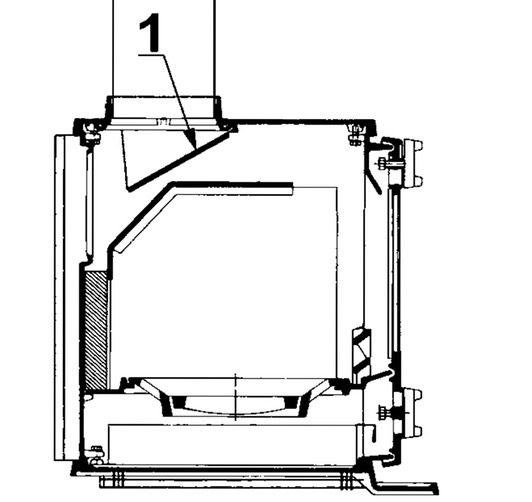
The part number 1 in the stove cross section diagram above (copied and pasted from the Morsø Squirrel 1400 Installation Manual) is the smoke hood refered to in this blog update.
On RoJo the flue dosn't reach 2m high and 10 years after being installed by a “professional" installation engineer, the smoke hood was still in place. The effect was that the flue never got hot enough to draw efficiently so when fuel was burned tar and creosote was produced and had, over the years, deposited inside the flue in such quantities that the flue was no longer 4” (100mm) diameter but just over 2” (50mm). The flue was blocking when a chunk of the solid tarry material flaked off and fell across the flue.
I tried undoing the two bolts holding the hood in place - well that was never going to happen so when pal Mark arrived he ferried me to Screwfix in Chester where I bought a cheap and cheerful angle grinder, that very quickly sorted the problem., after which we spent a considerable time getting the caked on scale off the inside of the flue - an ‘orrible and messy job.
After all that the stove started quickly and easily with no smoke coming into the boat just lovely heat and a cheery glow in the door glass.
I now have to relearn how to use the stove as it behaves in a totally different way to last winter. It seems more controllable and less greedy with fuel but time will confirm or deny that.
The greatest concern is that all the cases where I had heard about this installation error have been installations made by so called “experts”. Owner installers it seems read the instructions when installing the stoves, “experts” don’t seem to feel the need.
After writting the above about our stove I was shocked this morning to read on a Facebook narrowboat group a post about this very subject and was amazed at the number of people who still have this smoke hood fitted, most of whom seemed to have adopted the “well it was fitted by Morsø so it must be OK” stance despite several people trying to draw attention to the manufacturers installation instructions. None admitted they may have a problem, some even spouted nonsense reasons for keeping them.
Will it take some poor boaters death from carbon monoxide poisoning before people start to realise that a huge number of social media experts are experts on every thing.
Particularly those things about which they know absolutely nothing.
OK rant over!! on with the blog.
By the time Mark arrived and we had fixed the stove we didn’t get going until Thursday morning. It started badly, I mentioned earlier that bridges were difficult to negotiate because the speed of the current rushing against us through the restricted space caused a sharp increase in the speed of the current. Going through one bridge I was not quite square to the current which immediately took control and slammed us into the bridge tearing a small hole in our super new cratch cover - Oh Blow!! I’m fairly sure that was the expression I used.
Friday was a long but exciting day (11.5 miles, 18.5 kilometres), shortly after leaving the mooring we went over Chirk Aqueduct - WOW!! Almost immediately after the aqueduct was the Chirk Tunnel although at only 421 metres long it is quite short but the current against us made it a quite an experience as we crept through at a snails pace despite very high engine revs. We later spoke to several hire boaters who, until we explained about the current, had intended to phone their hire companies to report engine problems.
We were still in the thrall when almost immediately we cruised onto the Pontcysyllte Aqueduct - WOW WOW and WOW again. I don’t have the skills to describe this World Heritage Site adequately so hope the videos (below) and the photos will give you an idea of what a special place it is. Although sadly I was so enthralled with it videoing and photographing took second place to looking about with my mouth open.
I have also embedded a Canal and River Trust YouTube video about the Pontcysyllte Aqueduct.
Immediately the other side of the aqueduct is the Trevor basin where many boats turn around and go back over but we elected to carry on to the next winding hole. After the aqueduct the canal was wide enough for two boats to pass but both sides of the canal were very shallow. We passed just one boat and as we passed each other we both went aground.
Quite soon we reached and used the winding hole and had made our way back over the aqueducts and through the tunnel mooring at the end of an exhausting but exhilarating day with summer 2021 cruising objective complete.
We moored that night just south of bridge number 19W just a short distance from the appropriately named Bridge Inn where Mark treated us to a very pleasant meal.
The following day we arrived back in Ellesmere where we managed to get a spot on the 72 hour moorings just opposite the services point and less than five minutes walk from both Tesco and where Mark parked his car.
Continuous Cruising Week 144th - 11th Oct’ 202 and CC Week 1511th - 17th October 2021
Purple mooring locations are on the Staffordshire and Worcestershire Canal.
Orange mooring locations are on the Shropshire Union Canal.
Brown mooring locations are on the Llangollen Canal.
.-.-.-.-.-.—.-.-.-.-.-.-.-.-.-.-.-.
CC Week 14 4th - 11th Oct’ 202
Monday and Tuesday slipped past with more shopping and a 9.00am on Wednesday morning when the River Canal Rescue (RCR) engineer arrived and started servicing the engine . A task that was completed in a couple of hours during which time Sue got the laundry bang up to date - there was not much to do as we had done it just last week. The afternoon was spent, guess!!
Yes your right - shopping.
We were more than ready to get moving again, Thursday morning. We had planned to go back on to the Staffs and Worcs Canal stopping a couple of miles beyond where we reached before, Tixall Wide. Unfortunately the services point at Great Haywood was so busy it took us over 1.1/2 hours to get the water tank filled and the rubbish deposited in the proper bins by which time we had lost the appetite for another two hours cruising so we went for around a half hour to moor where we had two weeks ago. Bright and early Friday morning we set off from Tixall Wide into new territory. We went further than we had intended, although we did stop for a quick lunch, cruiseing for over six hours passing through seven locks eventually mooring after 10 miles in Penkridge outside the Cross Keys pub. Sadly the pub had no website so we were unable to discover the type of food sold and the reviews on Google Maps were, to put it politely, mixed.
We ate on board.
When we set out next morning (Saturday) we determined not to cruise for so long. We travelled just 5.3/4 miles and passed through 5 locks all in a touch over four hours.
Sunday saw us leaving the Staffs and Worcs Canal and joining the Shropshire Union Canal but first we had to negotiate “the narrows” that seemed to dominate the last mile or so as you approach Autherley. At this time of year they were not a problem as we didn’t meet a single boat coming the other way. There are one or two places that are, supposedly, wide enough for two boats to pass, yea in a pigs ear!!
After the stress of the narrows we were looking forward to the Autherley Junction as the photos we had seen showed a wide open area with the Shropshire Union Canal on the right. Although there was a bridge right at the junction that blocked any view of approaching boats with Sue sitting in the bow reporting to me on the helm by walkie talkie radio, every thing was going swimmingly until we were able to see that the boat we were following had stopped to set the first lock which was just beyond the bridge with absolutely no room for us. Fortunately we were able to hover in the entrance until the boat in front went into the lock then moved into the space they had just vacated. Soon we were through the lock and onto, for us, another new canal the Shropshire Union Canal, often referred to as “The Shroppie”. The main line was the last trunk narrow canal route to be built in England. It was not completed until 1835 and was the last major civil engineering accomplishment of Thomas Telford
Like the section of the Staffs and Worcs Canal approaching Autherley early parts of The Shroppie are very narrow and suitable for one way working only. While passing through these sections, like before, we didn’t meet a single boat but I would imagine that at the height of the season these sections would be very busy indeed. We moored for the night in a cutting just beyond Bridge number 10, quiet, peaceful, not another boat in sight - fabulous.
CC Week 15 11th - 17th October 2021
This week we are planning to push on towards the Llangollen Canal. The winter stoppages start on that canal on 8th November so it is looking increasingly unlikely that we will be able to do justice to a trip on it this year but we will assess that when we reach the junction.
Monday, after stopping for a look around in the pretty village of Brewood (pronounced Brood) we cruised 7.1/2 miles passing through just one lock and mooring in a very pleasant spot opposite High Onn Wharf permanent moorings but, far more importantly, right next to a tree laden with ripe sloes. We picked a good quantity and will make some Sloe Gin in the next few days. We covered seven miles on Tuesday passing through Selmore embankment where trees shield what would otherwise be panoramic views.
When the canal was planned an embankment was not envisaged but landowner Lord Anson refused permission for the canal to pass through Selmore wood. The canal is supported on the left by the mile long Shelmore Embankment. While the navvies tried to complete the mighty task, the bank slipped and collapsed many times.
By early 1834 this section was the only uncompleted part of the whole canal. It took five and a half years' continuous work and was finally finished in 1835, many months after canal engineer Thomas Telford's death. There are flood gates at each end to close the channel in case of a breach.
Throughout its 175 year existence there have always been stability problems, and there still are. The whole length is lined now with mature trees, and their roots do help. This was not the case in the canal's early years. It certainly feels a strange spooky place, as was Grub Street Cutting, over a mile shrouded in vegetation that disguises the fact that the cutting is 80 feet (24.3m) deep, much of the spoil of which, along with that from Gnosall, was used to build the Selmore Embankment. Shortly after emerging from the Grub Street Cutting we moored almost outside the Anchor Pub at bridge 42. What a pity it was not open.
Thursday saw us continuing our cruise along the Shebdon Embankment, through the Woodsheeves Cutting and the five lock Turley Flight which will long be remembered because there is, apparently, a sign in lock 4 that says the lock 5 should be set and the gates open before you leave lock 4. The notice is, we are told, unreadable (I didn’t even see it) I left lock 4 cruised to the lock 5 landing and went hard aground. There are so many underwater obstructions that there is effectively no lock landing at the top of the lock. It took our long pole, the help of a couple of dog walkers and a good half hour to get us free and on our way. After nine interest packed miles we moored at the visitor moorings at Market Drayton.
We should, perhaps at this point, have decided not to continue our headlong race towards the Llangollen Canal but to slow down, relax and enjoy our beautiful Shropshire surroundings but Thursday we continued our headlong rush onwards passing through not one, not two, but sixteen locks eventually mooring between locks 11 and 12 of the 15 lock Audlem Lock Flight after an exhausting 6 hours taking us just 5 miles.
Our cruise today (Friday) took us the same distance as yesterday but with only 6 locks we did it in half the time mooring on the embankment overlooking the town of Nantwich in time for lunch. In the afternoon we had a wander round the very pleasant town.
Saturday, and we are onward, ever onward. After stopping at the services to refill our water tank and get rid of our rubbish we set off on the final 2 miles (3.2km) to Hurleston Junction where the Llangollen Canal Meets the Shropshire Union Canal. We had decided that with 21 days before the first winter stoppage on 8th November we could safely travel to Trevor Basin on the far side of the Pontcysyllte Aqueduct and back with lots of time to spare, particularly if we did a couple of long days. When we moored at Wrenbury Visitor Moorings that night we had the first six miles of the Llangollen Canal behind us.
Sunday we continued along the Llangollen Canal, a very different canal from those we had cruised before and unique in that it is the only canal on the system that has a current as it is used for taking water from Wales to Chester and Nantwich in England where it is treated and used for drinking water. This makes more of a difference than you may think in that apart from the obvious time difference when travelling in different directions, Canalplan AC suggests a trip from Hurleston Junction to Trevor Basin will take around 32 hours while a trip from Trevor Basin to Hurleston Junction would take around 21 hours. Passage against the current going through bridge holes needs total concentration as the water speeds up greatly when the width of the canal goes from around 20 feet (6.0m) or so to around 8 feet (2.5m) or so with the same volume of water needing to pass. When going through bridges you must line the boat exactly with the flow of water, if not the water flow will force the boat bow to one side giving the bridge or tow path wall a powerful clout (I discovered this the hard way).
Sunday night, after a day which included ten locks and 5 lift bridges which, apart from the electrically operated one as we left Wrenbury, each required around 80 turns of the winch handle to lift it and another 80(ish) to close it - hard work indeed, was spent on a quiet secluded mooring at Duddleston Bridge visitor moorings.
Continuous Cruising Week 12 20th-26th September 2021 + Week 13, 27th Sept' - 3rd Oct’ 2021
Continuous Cruising Week 12, 20th-26th September 2021
It’s moving Monday. We have been at this isolated mooring for two days and may well have stayed longer but you may have noticed I wrote “isolated” not “isolated and peaceful”. There was just one dwelling anywhere near, a farm around a quarter of a mile away. Sadly, for us, the residents there had a super sound system and liked their music played
LOUD, LOUD, LOUD.
They played music, not our idea of music of course, morning, noon and night. Fortunately they went to bed around the same time as us but got up slightly later so it was not a disaster just a constant irritant that did not drown our TV sound but did intrude upon the quiet bits.
We set of towards Tixall Wide, where we plan to stay for a few days while I do some more maintenance tasks. We continued our journey up the Trent and Mersey Canal; the canal follows the route of the River Trent from the outskirts of Rugeley to beyond the junction with the Staffordshire and Worcestershire Canal at Great Haywood Junction.
There are a number of large houses in the area built for the rich, among them Bishton Hall, a former public school, which was recently bought (August 2019) by Hansons Auctioneers, the company owned by auctioneer and TV presenter Charles Hanson who then auctioned the contents which racked in a million quid.
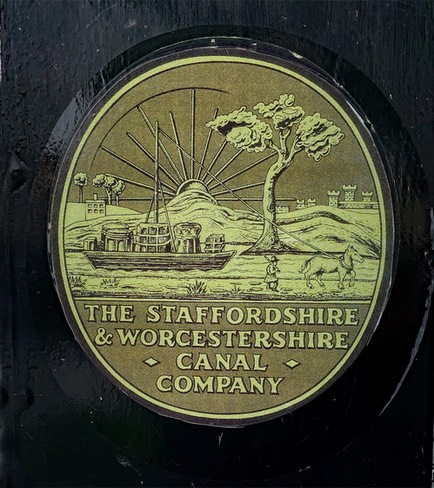
Being only a short cruise this morning with just two locks to pass through, we were soon at the Great Hayward Junction where we intended to turn left onto the Staffordshire and Worcestershire Canal, but first some jiggery pokery.
The water point was beyond the junction, only a little, but still beyond. We went on and managed to get the last spot on the water point landing. Another boat was also trying to get on the water point so I suggested he breast up, (tie up alongside us), which he did. We waited for three other boats to fill their tanks then filled ours when the boat breasted up to us was able to move into a spot in front of us. We then reversed off the landing and continued until we were back the right side of the junction and were able to turn onto, for us, another brand new canal The Staffordshire and Worcestershire Canal. This canal was built in 1771 by James Brindley and was part of his "Grand Cross" plan for waterways connecting the major ports at Hull, Liverpool, Bristol and London. The canal was a success and despite competition from other new canals and the railways and, although falling steadily from 1860, the Staffordshire and Worcestershire Canal Company paid dividends to its shareholders until nationalisation in 1948. In 1959 the British Transport Commission planned to close the canal but it was saved by a volunteer group, the Staffordshire and Worcestershire Canal Society. In 1968 the canal was reclassified as a cruiseway, and the following year all of it was declared a Conservation Area.
After travelling up the canal for a little more than a half mile we moored at arguably the most popular spot on the canal - Tixall Wide. As it’s name implies it is a wide section of canal, around 300ft (100m) wide. There are two stories as to why this section is so wide, the first is that the owners of Tixall Hall would only give permission for the canal to cross their land if it looked, from their house, like a lake not a canal and the second that Brindley took advantage of a pre-existing natural lake where, according to legend, Isaac Walton learned to fish. The Tixall Hall sadly long since demolished, was where, in 1586, Mary Queen of Scots was imprisoned for two weeks.
This is such a beautiful spot we have decided to stay here for some days, partly chilling and partly wrestling with the engine bay refurbishing, for which to do a top notch job a small victorian child is needed to get into all the tiny spaces but as using child labour is definitely not ”PC” this fat lump will have to do the best he can'
Although we probably did not need shopping we have learned that there is a farm shop back at Great Hayward Junction so today (Tuesday) we took a wander down there, it’s only just over a half mile so no great problem. The farm shop was a bit of a mish-mash in that it had all sorts of goods for sale that really did not seem to fit with the idea of a traditional farm shop. However the greengrocery was top notch, the butchery seemed first class (we will be back later in the week for a shoulder of lamb for Sunday dinner) and the other food departments also appeared to sell only the best quality available. Not cheap but very good. We will go back before we leave Tixall Wide. The sunset tonight was quite beautiful and lasted for ages.
We had a very pleasant Wednesday, we wandered to Great Haywood Junction partly for the exercise on such a pleasant day but mainly as an excuse to put off climbing into the engine bay, but I won’t be able to put it off all day. I did get down into the bay in the afternoon but didn’t get very much done. The further into the bay I get the less space I have and the more difficult it gets.
Another problem has come to light. Tucked right in the corner of the engine is the hot water cylinder, it is supported on a square piece of ply which in turn rests on two timber bearers, giving a gap between the baseplate and the ply of around a half inch and it is not possible for me to remove the cylinder and it’s mounting board to refurbish the baseplate without removing the engine and that simply ain’t going to happen. So I cleaned as far as I could under the cylinder and then sploshed lots of rust convertor around it and as far under it as I could get and that will have to do.
Continuous Cruising Week 13, 27th Sept' - 3rd Oct’ 2021
The reason we have been moving very slowly is that I have an engine service booked on the 6th October and I have told the RCR (River, Canal Rescue) that we will be somewhere on the The Staffordshire and Worcestershire Canal between Great Haywood Junction and Aldersley Junction a distance of just 21 miles then and on the 30th Sept’ I need to ring the RCR to let them know exactly where we are so the engineer can find us.
Today (Monday) we had to move ‘cos we were running short of water and if I were to finish the jobs I had started I needed to get some bits and bobs so we went back to Rugeley. It was an interesting cruise. Leaving the mooring we had occupied for the past six days the first task was to turn round. With Tixall Wide being some 300 yards (100 metres) wide I simply put the helm over and turned 180˚ - Easy Peasy. Just as well that was easy as just a half mile away was Haywood Junction we needed to turn right onto the Trent and Mersey Canal then reverse to the water point. It should have been easy but for the wind. I turned right got the boat turning in the right direction, put it in reverse and the wind pushed the bow in the opposite way to that I needed. Repeating this sequence a number of times I eventually got the boat on the water point and we were able to fill with water, dispose of our rubbish and swap (at an unbelievably high price) our empty gas cylinder for a full one. Jobs all jobed we set off for Rugeley. The first of the two locks went very well, Sue assisted a boat coming up then we went down, quick and slick.
We have not done much cruising in the rain, but we did today, the rain persisted down, stair rods. Fortunately not for long and by the time we reached our second and final lock of the day the sun was starting to peep around the clouds, just as well as there was a queue at the next lock which took us over, well over, an hour and a half to get through.
We soon after arrived in Rugeley, continuing through the town we checked out the available moorings, turned at the winding hole went back to town and took a pleasant mooring just yards from that we had last week.
It occurred to us on Tuesday that, as we have everything to hand, shops, laundrette etc., etc., we should stay her until the service is done. OK it’s miles from the water point but the service is in eight days and we have water for around fourteen (if we are very careful) so no issue there. The remainder of the week was spent (Wednesday) doing the washing and Thursday, Friday, Saturday and Sunday Shopping - well we don’t often moor close enough to not just one but two supermarkets to get a months food stocks.
We have been desperately worried about the fuel shortage. We have used around 180 litres of diesel since 5th July and last filling up on 20th August, thats seven weeks so means we used around 20 litres a week so as long as we can fill up in the next 10 weeks we should be OK 😁 😁 😁 😁 and just to rub it in we use red diesel with a base price of around 85p although that is what we pay for the proportion of the fuel we use for heating and hot water, we do have to pay duty on the portion we use for propulsion which is still, I understand, not quite the duty you all pay for the diesel you put in your cars.
Continuous Cruising Week 11.13th - 19th Sept. 2021
Mark went home after lunch today so we did not move but got ready for the heavy rain forecast for Tuesday when again we planned to stay just where we were, and rain it did. In buckets. We still managed to get some jobs jobbed so it was at least a reasonably productive day.
The first move of the week was on Wednesday when we left the Coventry Canal and went onto the Trent and Mersey Canal travelling north west. The first actions of the day were to first go through a swing bridge and then rise up the last three locks of the Fradley flight of six. The entire flight rises 40’-10” with the last three rising 20’-4”. I have included, below, a “slow TV” film of the journey from just after leaving the mooring to leaving the second lock. If you are daft enough to watch it in it’s entirety you will realise what a frenetic life we lead😊😊.
Our total journey on Wednesday was 7 miles and we were lucky enough to get the last available mooring close to Rugeley town centre with Morrison and Tesco just 5 minutes stroll away and a launderette just 10 minutes easy walk away, so Thursday was spent shopping and doing laundry.
Rugeley’s is noted in guide books for two reasons, the first that it was home to the notorious victorian poisoner William Palmer.
It was estimated that 30,000 people gathered outside Stafford Prison on 14 June 1856 to witness William Palmer hang. His had been the trial of the century, a case so notorious that, to avoid a prejudiced jury, the trial was moved from its local jurisdiction to the Old Bailey in London by a special act of Parliament, which, of course, only served to increase interest.
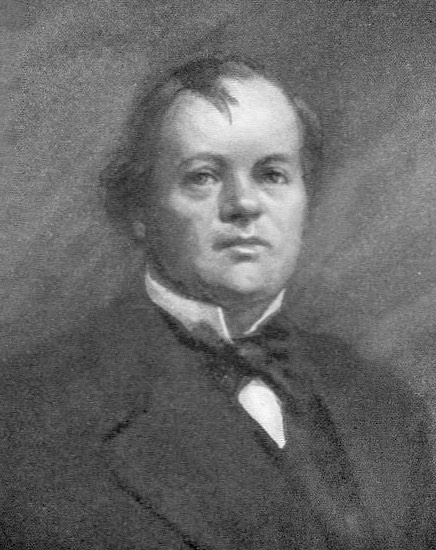
William Palmer
Palmer had returned to his native Rugeley in Staffordshire after training to become a doctor, married local woman, Ann, and seemed destined for the quiet life of an English country doctor. Within a few years an addiction to betting on horse racing led him to effectively abandon his practice. He fell deeply into debt and then his closest relatives started dying.
First was his mother-in-law, in Palmer’s home in 1849. Palmer’s wife inherited a trust but upon her death the trust would revert to the mother-in-law’s family and not pass to Palmer, who took out three life insurance policies on his wife totalling £13,000. Ann Palmer died in September 1854. In January of the following year, Palmer insured his brother Walter, again for £13,000. Walter died August 1855. The insurance companies refused to pay out on Walter and assigned a private detective to the case.
Palmer’s now desperate financial state led to another alleged murder. In November his associate and betting partner John Parsons Cook won a handsome sum, then grew strangely ill. Palmer collected the winnings, and after several days of his ministrations, Cook died.
Alfred Swaine Taylor (1806–1880),known as the father of english toxicology became involved when an inquest was called into Cook’s suspicious death, the stomach contents and viscera were sent to Taylor at Guy’s Hospital in London for chemical analysis.
Taylor, at the height of his career became the star witness in the case, ensuring Palmer’s conviction.
Ironically, it was not chemical analysis that sealed Palmer’s fate. Taylor told the court that the spasms Cook displayed in his paroxysms of death could occur only in cases of tetanus and strychnine poisoning. Tetanus was ruled out, Taylor deduced poison.
Even after his conviction Palmer never confessed to the crime. He went to the gallows saying, “I am innocent of poisoning Cook by strychnine,” an enigmatic denial that, paired with ambiguous forensic evidence, has created an enduring mystery.
Also closely linked to Rugeley is the rape and murder of Christina Collins.
This second story is that on 15 June 1839 37 year old Christina began a journey on a narrowboat from Liverpool to London to join her husband Robert, who was working there.
During the Victorian age, movement by canal was generally the quickest and most cost effective way to move around Britain, with many boats being used for transport of both goods and people. One group that used the canal for transport was Pickford’s moving company. Christina Collins had booked passage with NB The Staffordshire Knot, skippered by James Owens and chartered to Pickfords.
Owens and his friend William Ellis had worked together for some years, both men having worked on the inland waterways for most of their lives. The other crew members were George Thomas and a 12-year-old cabin boy Isaac Musson. They loaded cargo at Preston, and taking Christina as their only passenger they set out for London. The crew had a reputation for violent and drunken behaviour that Christina was apparently unaware of when she booked passage.
Christina tried to settle down amongst the cargo-filled boat, where the crew, still drunk from the previous night appalled her with their bad language and drunken behaviour. When the boat stopped at Stoke-on-Trent she complained to Pickford’s Office about the crew and the inappropriate behaviour by Owens. She requested transfer to another vessel but this was denied and Christina returned to face the crew of The Staffordshire Knot. The barge again stopped at Stone, where Christina again complained to a clerk, who whilst aware of Owen’s reputation was unable or unwilling to assist and instead urged her to report matters to Pickford’s upon her arrival in London.
The next morning the narrowboat stopped once again near Rugeley, where Isaac, the 12-year-old Cabin boy was asked to take the horses pulling the boat and its cargo further down the canal so the crew could deal with the lock gates. The crew had drunk huge amounts of alcohol the night before and it quickly became clear to Collins just what Owens’ intentions actually were.
It was around this time that the lock keeper reported to have been disturbed by a woman’s screams. Investigating, he saw Owens and his crew throwing a young woman into the boats cabin, but any alarm was settled when Owens assured him that the screams had been from a drunken woman travelling down the canal with her husband, and that he too had been alarmed by the screams.
It was now that cabin boy Isaac returned to the boat was was told by the other crew members that Christina had disappeared, and that they had searched but were unable to find her. The same day Isaac, concerned as to Christina’s whereabouts, reported what had happened to the lock keeper and ran from the boat. On loosing their cabin boy the remaining crew also abandoned the boat.
Putting together what he thought had happened, the lock keeper reported Owens and his crew to the police, who searched the boat and discovered a female bonnet and shoes.
A search of the canal, sweeping sections at a time, was organised and Christina’s body was found wrapped in chain. A horrified local dragged her body up the steps from the canal to the Talbot Inn, where surgeons concluded that Christina had been murdered, but only after “ . . . the capital offence of violation had been committed, apparently with great barbarity . . .”. Legend states that her body bled during its transportation up the steps, and her blood sank into the steps. and that that despite being replaced several times, the steps will ooze blood upon cold dark moonlit nights.
The hunt for The Staffordshire Knot crew began upon the surgeon’s conclusion of murder and violent rape, William Ellis was first to be apprehended near his home in Brinklow and at first denied that murder had occurred claiming that Collins had simply fallen overboard. He was taken into custody, and later disclosed that George Thomas had a ” . . . hidey hole . . . ” he used by his mother’s cottage. The police found him in a small chamber cut into the wall at the rear of the property. James Owen was finally captured after being caught in early 1840 when he attempted to visit his wife in Brinklow. All three men were held in Stafford Gaol for their trial in April 1840.
A key witness at the trail of the three men was Joseph Barnsley, who had made and marked the chain wrapped around Mrs Collins on the night of her death. He knew, thanks to his personal mark, that the chain had been sold to Pickford’s and would thus have to come from The Staffordshire Knot itself. Following the trial James Owens, William Ellis and George Thomas were found guilty of the rape and murder of Christina Collins. Owens and Thomas were hanged in Stafford while a crowd of around 10,000 watched. Ellis was transported to Australia for life. The cabin body Isaac was cleared and released.
Christina Collins was buried in St Augustine’s Churchyard. Her gravestone still serves as a memory of her murder, and is engraved with the following message…
“To the memory of Christina Collins, Wife of Robert Collins, London, who, having Been Barbarously treated was found dead in the Canal in this parish on June 17th 1839, age 37yrs. This stone is erected by some individuals of the parish of Rugeley in communication of the end of the unhappy woman”.
I have found pictures on t’interweb of a statue in Stone, Staffs that has no plaque to explain its existence but THIS WEB SITE talks authoritatively as to its meaning.
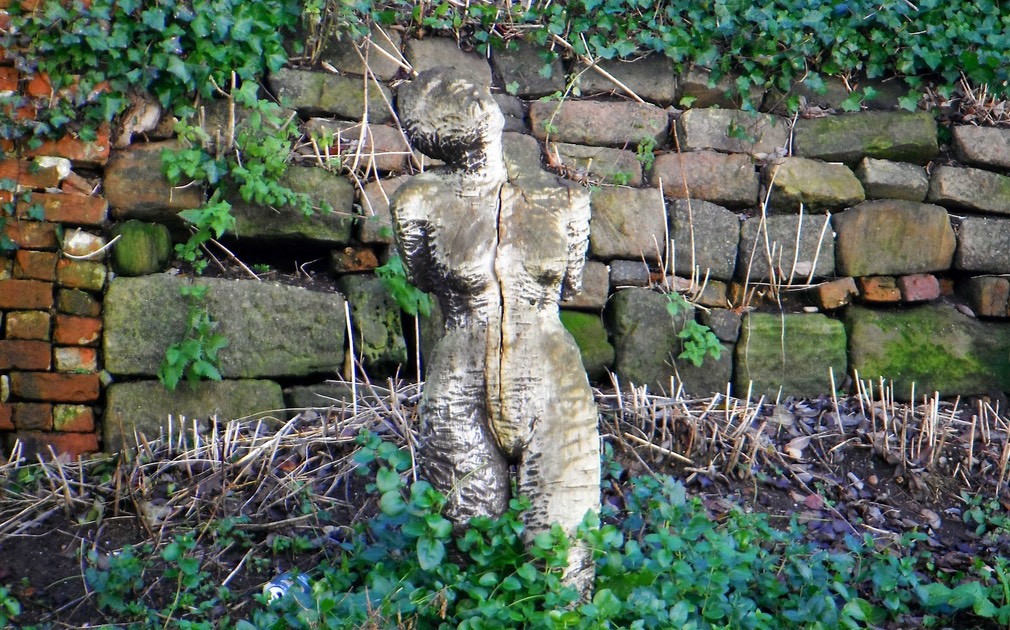
Friday and we were on the move again but not until we had wandered up to Morrison to take advantage of their half price breakfast offer - three rashers of bacon, two sausages, hash brown, grilled tomato. grilled mushrooms, beans and buttered toast all for just £2.85. It would have been rude not to have taken advantage of that offer 😁.
We got underway at 10.00 am and just 2 miles later we saw a one boat length of armco with great views all round and decided to stop for a couple of days - well we had been going for all of an hour and 10 minutes.
I finally got round to starting a job I have been putting off ever since we bought the boat, scraping any rust from the base plate in the engine bay treating with chemical rust convertor and then repainting. It is actually a large space divided into three areas by the engine which makes access a nightmare. What is needed is a very small contortionist but I managed to get the port side scraped clean of all loose rust scale using a multi-tool with a chisel blade, prepared ready for rust treatment tomorrow, when I will no doubt be suffering from todays exertions.
Lots of aches and pains in these old muscles and joints this morning but being the hero that I am I climbed back into the engine bay, gave the prepared area a thorough vacuuming and coated all that I had prepared with a good soaking of Firtan Rust Convertor. I had hoped to get two coats of bilge paint on the area ready to receive it today (Sunday) and did indeed get the first done immediately after breakfast and with luck had hoped to get another on before it got dark and damp in the afternoon - yes, I know the technical data sheet says time between coats 16 hours - and on this occasion the data sheet won as I didn’t get the second coat done.
Continuous Cruising Week 10.6th - 12th Sept. 2021
Mark had an appointment he could not miss on Tuesday so we decided to have Monday and Tuesday as lay days doing not very much, although Mark did take the bike with him when he went to his appointment and before returning to the boat parked the car ahead of us and cycled back.
I feel that I have given the Coventry Canal something of a bad press so have included the video below to show how rural the canal is for most of its length.
On Wednesday we continued along the Coventry Canal, mooring between locks 5 & 6 on the Atherstone Flight of 11 locks. We considered ourselves very lucky to have got a mooring where we did, as it was very close to the town, close enough for Mark to take us to dinner in the canal side Kings Head pub. Thank you Mark it was very enjoyable.
Thursday morning saw us wandering through Atherstone town, and what a pleasant town it is. The high street is still full of independent shops which along with the other shopping streets was very vibrant and buzzy. For those that needed their big store fix at one end of the high street there was a large Co-Op and an Aldi.
After spending much of the morning in Atherstone we dropped down the remaining six Atherstone locks and travelled just a mile or so before mooring for the night just after Bridge 50.
Shortly after getting underway on Friday we passed through the town of Polesworth where there is Polesworth Abbey a Benedictine nunnery we fancied seeing so we moored and walked the short distance to the abbey but were disappointed that it was locked and bolted with no access during these covid times. However the graveyard along side made for a fascinating wander among the grave stones.
We almost reached the end of the Coventry Canal today, Saturday, however Fradley Junction where the Coventry Canal meets the Trent and Mersey Canal is a very busy junction and we were doubtful that we would get a nearer mooring at this time of day so we moored about a mile before the junction and around 10.30 on Sunday morning I wandered up to the junction where there was a boat getting underway, so just one vacant mooring, within minutes most of the boats moored overnight had also upped and left.
Contacting Sue and Mark they brought the boat up and we moored just yards from Fradley Junction swing bridge.
Here we were able to empty the bins and do all the other tasks necessary to boat living. Mark was planning to go home today but learning that Sue was cooking a roast duck dinner elected to stay one more night and suggested that as the National Memorial Arboretum was just 4 miles away we jump in his car and visit. The Arboretum was a fascinating place. There are road train tours, golf buggy tours and guided walking tours or you are free to wander at will around the 150 acres and almost 400 memorials nestled amongst some 25,000 trees. We opted for a guided walking tour which while interesting showed only a tiny fraction of what is there. Multiple visits at different times of the year are needed to fully appreciate what is on offer.
Oh!! and the duck dinner was superb - Thank you Sue.
Continuous Cruising Week 9.30 Aug - 5 Sept. 2021
For more details of the moorings we have used see our moorings page HERE
Monday was, or should have been, a short easy day just five easy lock free miles to where we had arranged to meet pal Mark, who was coming to stay with us for a week or two, just outside Willoughby but as we passed Midland Chandlers we noticed that, despite being a bank holiday, it was open. We backed onto their mooring and were about to go in when we noticed someone pacing out the space in front of us, I asked why and was told he was pacing to see if he could get his boat in front of us while he went into the chandler, it was obvious he could not so I suggested he breast up (moor) alongside us which he did. What we didn’t know when we made the offer that after finishing shopping he, and his wife wanted to chat, and chat, and chat, and chat, and chat . . . . . .
We didn’t move Tuesday. By the time Mark arrived and we all got sorted it was quite late we decided to get underway Wednesday when we got up early(ish) and continued north on the Oxford Canal towards the Hillmorton Locks reportedly the busiest on the system. The flight is three locks that drop a total of 18’ - 7” and was completed in 1774 although the final section of the canal into Oxford itself was not opened until 1st January 1790. The Oxford Canal became between then and 1805 the most profitable and important transport link in the country. A second set of locks was built alongside the original Hillmorton Lock Flight in 1840 that greatly increased capacity, a bonus today that pleasure boaters have twice as many chances of finding a lock in their favour. We managed to find three locks all in our favour and as a bonus there were “voli lockies” (voluntary lock-keepers) who did all the work on the last lock for us and then just yards beyond the bottom lock we found a good mooring for the night, allowing Mark to cycle back to last nights mooring to fetch his car which he then left at Hillmorton.
Thursday saw us reaching All Oaks Wood just outside the village of Brinklow where Mark cycled back to Hillmorton to fetch his car. We had chosen All Oaks Wood as we knew there was a car park there with plenty of dog walkers around to (hopefully) keep the car safe. On Friday we travelled from All Oaks Wood to around a mile before Hawkesbury Junction where we had a quiet mooring with not another boat in sight. Fabulous. Again, poor Mark cycled back to All Oaks Wood to fetch the car. Sadly because he has a very small car and can only fit one bike in the back he must do these cycle rides alone.
Saturday we started on the 5.1/2 mile run from Hawkesbury Junction to Coventry Basin in the heart of the city. We were a little nervous as we had heard all sorts of horror stories about that section of the Coventry Canal, the canal is filthy with rubbish, you can’t go far without getting someones' cast off tat wrapped around the propellor, people throw stuff on you as you pass under bridges, there are hundreds of abandoned shopping trolleys in the canal, the list goes on but as we chugged our way towards the city we were surprised at how clean the canal was. OK there was an amount of rubbish floating about and we did see a couple of abandoned shopping trolleys hiding in the depths of the canal (the water was clear enough to see them) and overall it was most definitely a more urban than rural environment but still very pleasant. We entered the basin and were looking for a mooring when we were informed that while Coventry held 2021 City of Culture status all moorings had to be pre-booked with the CRT (Canal and River Trust). Getting on t’interweb I managed to get the very last berth, which despite the pre-booking requirement was still free.
We took a turn around the small canal basin and were delighted to find, almost opposite our mooring, a Portuguese supermarket. It was as if Christmas had arrived early, we were able to buy wine, salt cod, pastel de nata (crispy pastry custard tarts), all sorts of tasty treats we thought we would never taste again. Having gone in for just a look around we still managed to spend best part of £100, but was it worth it? Yes!! - every single penny. We even went back Sunday Morning to get a few bits and bobs we had missed on Saturday and were rewarded with a gift of cakes iced with sweet icing in Portuguese flag colours of red, green and yellow. It seems it was the first anniversary of the shop opening.
We tried to extend our stay in the basin by 24 hours but all moorings for Sunday night were booked but we had till noon before we were required to vacate so we spent the time visiting both the old and new Coventry Cathedrals.
On the evening of 14 November 1940, over 500 bombers from the Luftwaffe (the German air force) targeted Coventry in the highly industrialised West Midlands. In the 12 hours of the raids, 568 people were killed and over 4,000 homes destroyed. Coventry Cathedral, dating from the 14th century, suffered a firestorm leaving it a virtual shell with only the tower and its spire still standing. In 1951 a competition was launched to find a design for a new cathedral: it was one of the most important architectural commissions of the post-war period. A plan submitted by architects Basil Spence & Partners was chosen from 219 entries. Preserving the ruined shell of the ancient cathedral as an integral part of the overall modern design was visionary, the whole was stunning with the most beautiful coloured glass panels everywhere you looked. The huge glass wall between the new cathedral and the ruins of the old was absolutely stunning but sadly I was unable to get into a position where a photo would do any justice to the actual article.
Shortly after our noon deadline we left the basin to continue our journey. On the canalside just outside the city is the row of cottages called Cash’s 100, built by silk weaver, quaker philanthropist brothers John and Joseph Cash who had planned to build 100 three story cottages, each with a garden and on the top floor of each cottage a well-lit work area, known collectively as 'Cash's Topshops', each housing a Jacquard loom, powered by a central, steam-powered beam engine. Only 48 were built and opened for business in 1857 and the individual workshops were combined into single, large, workspace in 1862. They were grade 11 listed in 1975. The video below shows the exterior of the building.
After a stop at Coventry’s Tesco Superstore to stock up with even more goodies we moored on the Coventry Canal a few hundred metres beyond Hawkesbury Junction.
Continuous Cruising Week 8. 23-29 Aug. ‘21
As the map on the “What’s New” page is getting complicated I have added, where possible, individual weekly mooring maps.
Monday and it’s moving day.
We like Banbury and hope to return some day but right now we must move on. The plan is to go to Cropredy as we missed it on the way down as we could not find a mooring anywhere. There is a Fairport Festival each year in Cropredy fronted over recent years by Fairport Convention that was advertised as "going ahead” which is why, we were told, that the moorings were so full. Although at the last minute the festival was cancelled but the pubs having laid out a great deal of dosh on food, extra alcohol stocks etc., carried on regardless with their programmes which, our source told us, was a great success.
Sadly things had not changed on the way back, we did manage to stop for a couple of minutes (virtually blocking the entire canal in the process) to get a black pudding ring but that was it. No spaces nowhere, so we continued to the public moorings at the bottom of the Claydon Locks. This flight of five locks, as a water conservancy measure is at the moment locked off between 6.00pm and 8.00am with the last entry to the flight at 4.30pm.
We got underway bright and early Tuesday morning and were soon through the locks and by lunch time we had done around six miles and stopped for the day in a very quiet rural spot where two other boats were already moored. After lunch both the other boats got underway and we were left totally alone. The aloneness sadly did not last and by the evening every space was filled.
Wednesday was to be a lay day as we thought, wrongly, we were near the ruins of a medieval village that was abandoned when plague made it a dangerous place to live. Not being able to visit the village we had to be content with a walk along the tow-path.
Our luck improved at evening mooring time. Not a single boat stopped to disturb our peaceful solitude.
Continuing our journey on Thursday brought us to the nine locks of the Napton Flight. The top two locks in this flight are also locked off at night from 6.00pm, last entry 5.30pm till 8.00am. This measure is according to the CRT “ . . . intended to reduce the potential for water losses overnight and allow back pumps more time to transfer water from the Braunston pound onto the Oxford Summit . . . “ speaking to a CRT volunteer he said that as the evening wore on and tired boaters looking forward to an evening meal and drinkies regularly left gate paddles open, thus exacerbating low water levels. We have seen a boat climbing a lock flight at 10.30 at night perfectly acceptable and legal but . . . . . . .
As we dropped down the locks we again saw the Indonesian Water Bufallo in the adjacent fields. We have found out where we can buy some of the burgers and sausages produced from the meat and will look to get some tomorrow.
Friday was declared another lay day which enabled us to visit the Napton Village Store and get some Water Buffalo sausages and burgers (which we had been told were delicious but will be able to give you our opinion next update), as well as the Napton Ciderey where we stocked up on some bottled cider.
Just before the second lockdown we had been taken to The Kings Head at Napton for what was an excellent meal and our plan for Saturday was, after going through the last lock of the Napton Flight and topping up our water tank at the water point, to carry on for just a very short distance (less than a mile) and moor as close to Bridge 109 which would, within a five minute walk, take us to the Kings Head where we could have, hopefully, another excellent meal.
We got to Bridge 109 to find the moorings virtually empty with just one small boat moored. We moored behind it got everything ready for an overnight stay but quickly got fed up with car drivers leaning on their hooters before going over the humpy back canal bridge. I can never understand this tooting nonsense, if you have to hoot you are going too fast. Rather than put up with the constant toot toot until it got dark when lights made hooters unnecessary we moved mooring to a pleasant rural section of canal close to bridge 103, not far from Braunston but sadly a long way from the Kings Head. Shortly after mooring pal Paul Smith went past on NB Orient and asked if we would be there Sunday morning. We said we would to which he replied "OK I’ll speak to you then". Paul was taking a client on one of his “Discovery Days” Sunday morning but stopped partly to provide coffee for his client and partly to have a quick chat with us and get us up to date with all the latest Calcutt Marina gossip. Later that afternoon there was a knock on the side of the boat, when we went out we found a couple who lived on their boat in Calcutt Marina. As they passed they recognised our boat and stopped to say “Hi”, we spent a very pleasant hour or two with them Sunday evening and again Monday morning before we went on our merry way.
